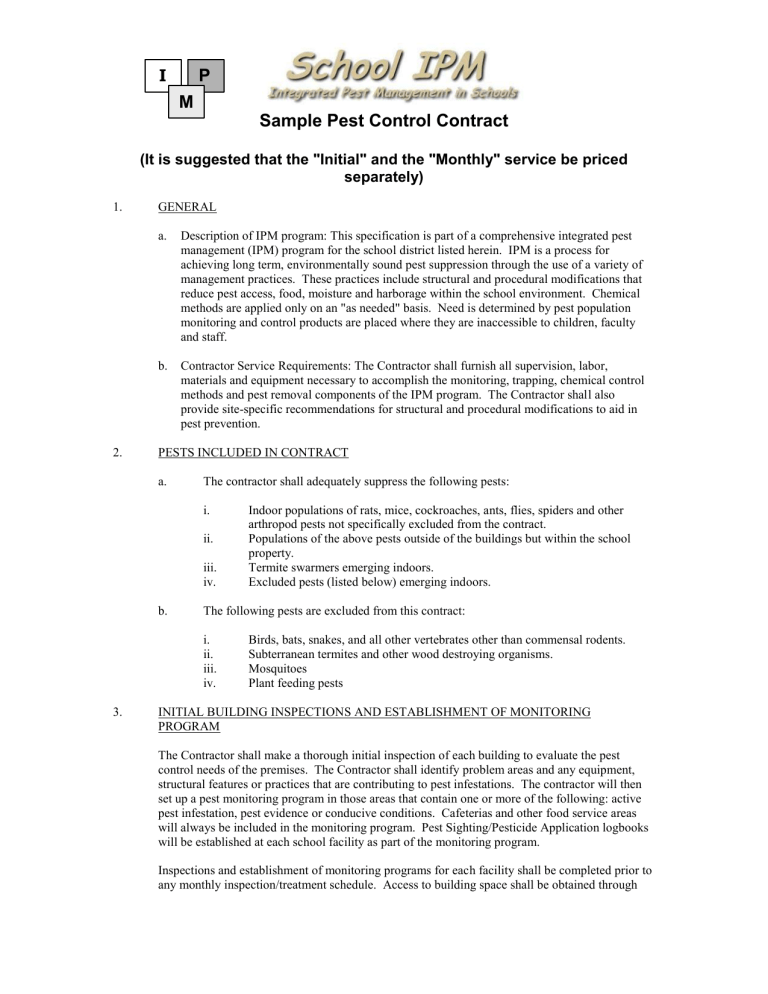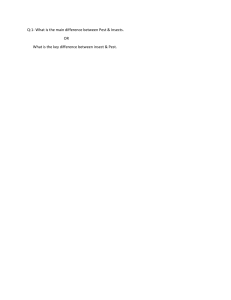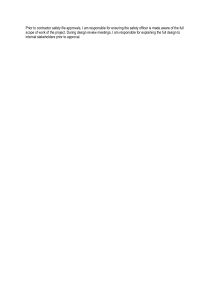
I P M Sample Pest Control Contract (It is suggested that the "Initial" and the "Monthly" service be priced separately) 1. 2. GENERAL a. Description of IPM program: This specification is part of a comprehensive integrated pest management (IPM) program for the school district listed herein. IPM is a process for achieving long term, environmentally sound pest suppression through the use of a variety of management practices. These practices include structural and procedural modifications that reduce pest access, food, moisture and harborage within the school environment. Chemical methods are applied only on an "as needed" basis. Need is determined by pest population monitoring and control products are placed where they are inaccessible to children, faculty and staff. b. Contractor Service Requirements: The Contractor shall furnish all supervision, labor, materials and equipment necessary to accomplish the monitoring, trapping, chemical control methods and pest removal components of the IPM program. The Contractor shall also provide site-specific recommendations for structural and procedural modifications to aid in pest prevention. PESTS INCLUDED IN CONTRACT a. The contractor shall adequately suppress the following pests: i. ii. iii. iv. b. The following pests are excluded from this contract: i. ii. iii. iv. 3. Indoor populations of rats, mice, cockroaches, ants, flies, spiders and other arthropod pests not specifically excluded from the contract. Populations of the above pests outside of the buildings but within the school property. Termite swarmers emerging indoors. Excluded pests (listed below) emerging indoors. Birds, bats, snakes, and all other vertebrates other than commensal rodents. Subterranean termites and other wood destroying organisms. Mosquitoes Plant feeding pests INITIAL BUILDING INSPECTIONS AND ESTABLISHMENT OF MONITORING PROGRAM The Contractor shall make a thorough initial inspection of each building to evaluate the pest control needs of the premises. The Contractor shall identify problem areas and any equipment, structural features or practices that are contributing to pest infestations. The contractor will then set up a pest monitoring program in those areas that contain one or more of the following: active pest infestation, pest evidence or conducive conditions. Cafeterias and other food service areas will always be included in the monitoring program. Pest Sighting/Pesticide Application logbooks will be established at each school facility as part of the monitoring program. Inspections and establishment of monitoring programs for each facility shall be completed prior to any monthly inspection/treatment schedule. Access to building space shall be obtained through the IPM coordinator. The IPM Coordinator will inform the Contractor of any restricted areas requiring special scheduling. 4. PEST CONTROL PLAN OF WORK The Contractor shall submit to the IPM Coordinator a Pest Control Plan of Work prior to inspection and establishment of the monitoring program. The IPM Coordinator and the contractor will review and negotiate the Plan of Work before any pest management services begin. The Pest Control Plan of Work will contain two service plans, Initial and Monthly: INITIAL a. Initial inspection: The Contractor will inspect the entire premises and report any structural or operational changes that would facilitate the pest control effort. Using a building floor-plan as a permanent record, the Contractor shall describe site specific solutions for eliminating pest access, food, water and harborage. b. Establishment of monitoring program: The Contractor will monitor the facility using lo-line (or other accepted design) sticky traps to determine any existing arthropod pest problems. The contractor will then establish a monthly monitoring program in the cafeterias/food handling areas, or locations where there is an active infestation, pest evidence or conducive conditions. Monitoring locations will be recorded in the Pest Sighting/Pesticide Application logbook. Logbooks will be established for each facility and kept on the premises. c. List of proposed materials and equipment: The Contractor shall provide current labels and Material Safety Data Sheets (MSDS) for all pesticide products to be used. In addition, the brand names shall be provided for all application equipment, rodent bait boxes, monitoring and trapping devices, and any other control equipment that may be used to provide service. MONTHLY 5. a. Service Schedule: The Contractor shall provide service schedules that include the monthly or quarterly frequency of Contractor visits. The Contractor will record the date of each visit in the logbook as well as all services received. b. Commercial pesticide applicator certificates or licenses: The Contractor shall provide photocopies of the company Pest Control License and dated Pesticide Applicator Certificates for every employee who will be performing on-site services under this contract. RECORD KEEPING The Contractor shall be responsible for maintaining a pest control logbook for each site specified in this contract. These records shall be kept on site by the IPM Coordinator and maintained on each visit by the Contractor. The logbook shall contain the following items: a. Pest Control Plan of Work: A copy of the Pest Control Plan of Work, including the labels and MSDS sheets and service schedule. b. Work request and inspection forms: Work request and inspection forms will be used to advise the Contractor of routine service requests and to document the performance of all work, including emergency work. All work shall be documented in the logbook then signed and dated by the Contractor. c. 6. Floor-plan service report: The Contractor will submit a monthly floor plan of the area serviced to the Pest Sighting/Pesticide Application logbook. The contractor will record any pest evidence detected by the monitoring program and the action taken. All chemical applications must be recorded on the floor plan and in response to a documented pest problem. Application information must include the date, location, brand name, and active ingredient of the product used. EMERGENCY SERVICE On occasion the Contractor may be requested to perform corrective or emergency service(s) that are beyond the routine requests. The Contractor shall respond to these exceptional circumstances and begin the necessary work within one working day after receipt of the request. 7. USE OF CHEMICAL CONTROL METHODS The Contractor shall be responsible for application of pesticides according to the label. All pesticides used by the Contractor must be registered with the U. S. Environmental Protection Agency, state and or local jurisdiction. The Contractor shall adhere to the following rules for chemical control products in schools: 8. 9. a. Approved products: The Contractor shall not apply any pesticide product that is not included in the Pest Control Plan of Work approved by the School IPM Coordinator. b. Application by need: Pesticide application shall be according to need and not by schedule. Such chemical control methods shall not be applied unless visual inspections or monitoring devices indicate the presence of pests in a specific area. Preventive chemical control treatments in areas where there is potential for insects or rodents will be evaluated on a case-by-case basis. c. Minimum risk: When the application of chemical control products is necessary, the Contractor shall employ the least hazardous materials, most precise application techniques and the minimum quantity of pesticide necessary to achieve control. INSECT CONTROL a. Emphasis on non-chemical methods: The Contractor shall use non-pesticide methods of control wherever possible, for example- use of portable vacuum for initial clean-outs of cockroach infestations, winged ants and termites or spider control, and use of trapping devices for indoor fly control. b. Monitoring: Sticky traps shall be used to guide and evaluate indoor insect control efforts wherever necessary. c. Insecticide bait formulations: Bait formulations shall be used for cockroach and ant control where appropriate. RODENT CONTROL a. Indoor trapping: Rodent control inside occupied buildings shall be accomplished with trapping devices only. All such devices shall be concealed and in protected areas so as not to be disturbed by school operations. Trapping devices shall be checked every 24 hours. The Contractor or designated school personnel will be responsible for disposing of all trapped rodents or rodent carcasses in an appropriate manner. b. Outdoor use of bait boxes: All bait boxes shall be placed out of general view where they will not be disturbed by school operations. The lids of the boxes shall be securely locked of fastened shut. All bait boxes shall be attached or anchored to the floor, wall, or other immovable surface so that the box cannot be picked up or moved. Bait shall always be placed in the baffle protected feeding chamber of the box. All bait boxes shall be labeled on the inside with the Contractor's business name and address. The Contractor's employee shall date the box at the time of installation and after each servicing. 10. STRUCTURAL MODIFICATIONS AND RECOMMENDATIONS Throughout the term of this contract, the Contractor shall be responsible for advising the IPM Coordinator about any structural, sanitary or procedural modifications that will reduce pest access, food, water and harborage. The Contractor shall be responsible for adequately suppressing all pests included in this contract regardless of whether or not the suggested modifications are implemented. The Contractor will not be held responsible for carrying out structural modifications as part of the pest control effort.






